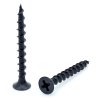- Joined
- Dec 27, 2020
- Messages
- 161
- Likes
- 406
Just saw this article on gizmodo concerning these new drywall screws that turn drywall into sound-absorbing panels. A new trend to follow?
According to the graph in the link it's good from 250hz up (-9db), so I'd say it's an awesome product por potentially peanuts.

So what's holding the drywall? It definitely doesn't appear that you could just use these as simply as ordinary drywall screws, as the article states.
According to the graph in the link it's good from 250hz up (-9db), so I'd say it's an awesome product por potentially peanuts.
If you need that gap - it would rule out retrofitting - at least without stripping off the existing drywall. You couldn't just remove the old screws and put in new ones.Just saw this on another website. It helps explain a little better how they are installed:
The spring forms of a gap of a few millimeters between the stud and the drywall's underside.”
Egellings - you have to figure in that soundproof (resistant?) drywall is a pretty standard thing. Universal for studios, but also routinely used in apartment buildings and anywhere you don't want to hear your neighbors. The idea is pretty much always to create an acoustic break between the outside and the inside. A typical strategy is to attach the drywall by a thin metal bracket so most vibration is forced to travel over a narrow bridge. Only so much energy will traverse a little metal bracket (aka resilient channel). So - less sound. I guess speaker spikes work on a similar principal, though probably with less need or impact. Sometimes laminated drywall is used - with an elastic goo between the layers. But that's more expensive and arguably less effective.
Just an aside about windows: Most people don't know this but when you order windows - like, say, double pane windows to replace those old classy looking single pane, you can spec thicker glass - usually for not much more money. Also you can spec that the inside and the outside have different glass thickness. That helps reduce noise transmission too. Laminated glass is awesome. I was surprised how much difference it makes and thumbs up for anyone with noisy neighbors (or if you don't want to be one). Resonances, damping, air volumes... Windows and speaker boxes have the same issues.And if you've gone to these lengths youve wasted your time unless you deal with the doors and windows
Which are more complicated and expensive than the walls.
Just an aside about windows: Most people don't know this but when you order windows - like, say, double pane windows to replace those old classy looking single pane, you can spec thicker glass - usually for not much more money. Also you can spec that the inside and the outside have different glass thickness. That helps reduce noise transmission too. Laminated glass is awesome. I was surprised how much difference it makes and thumbs up for anyone with noisy neighbors (or if you don't want to be one). Resonances, damping, air volumes... Windows and speaker boxes have the same issues.
